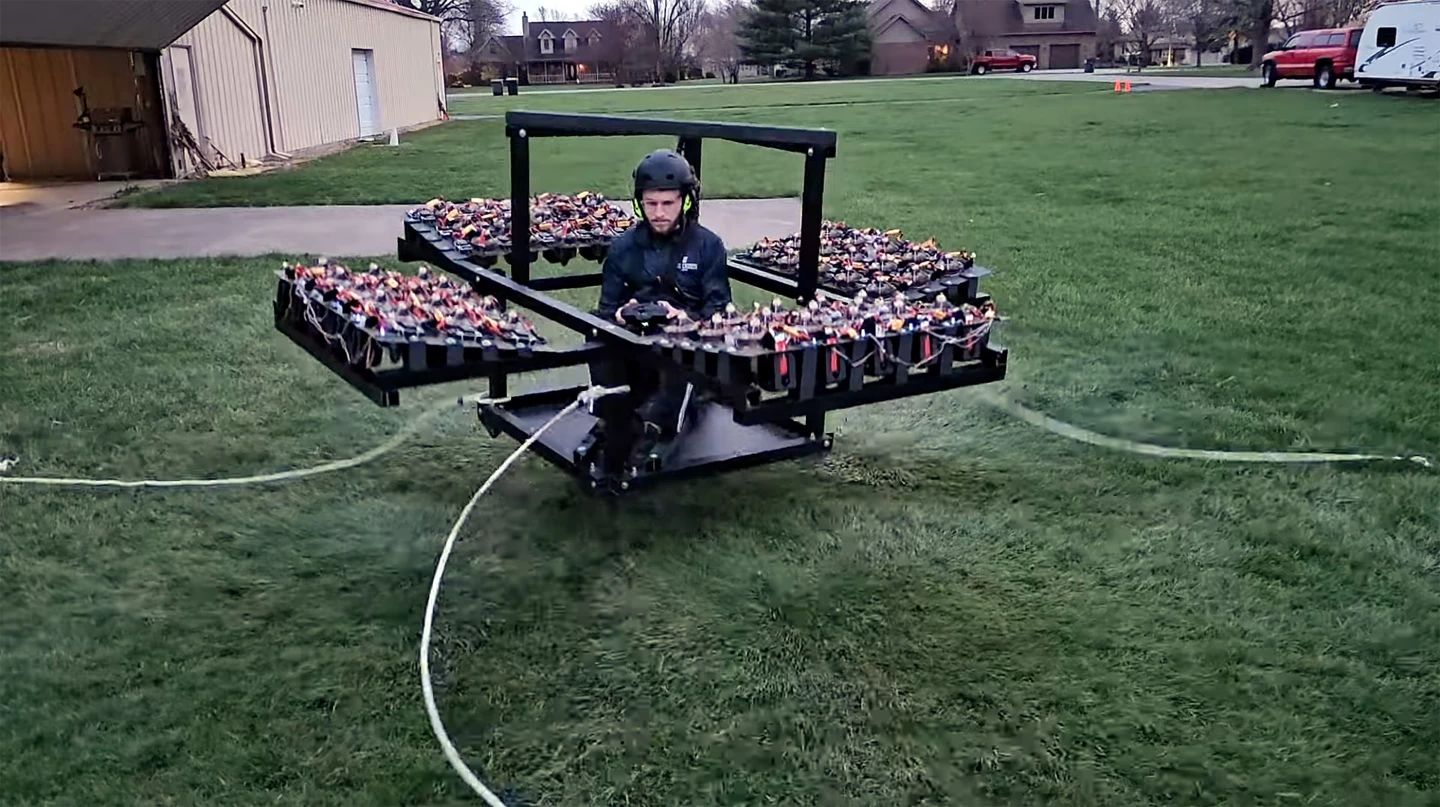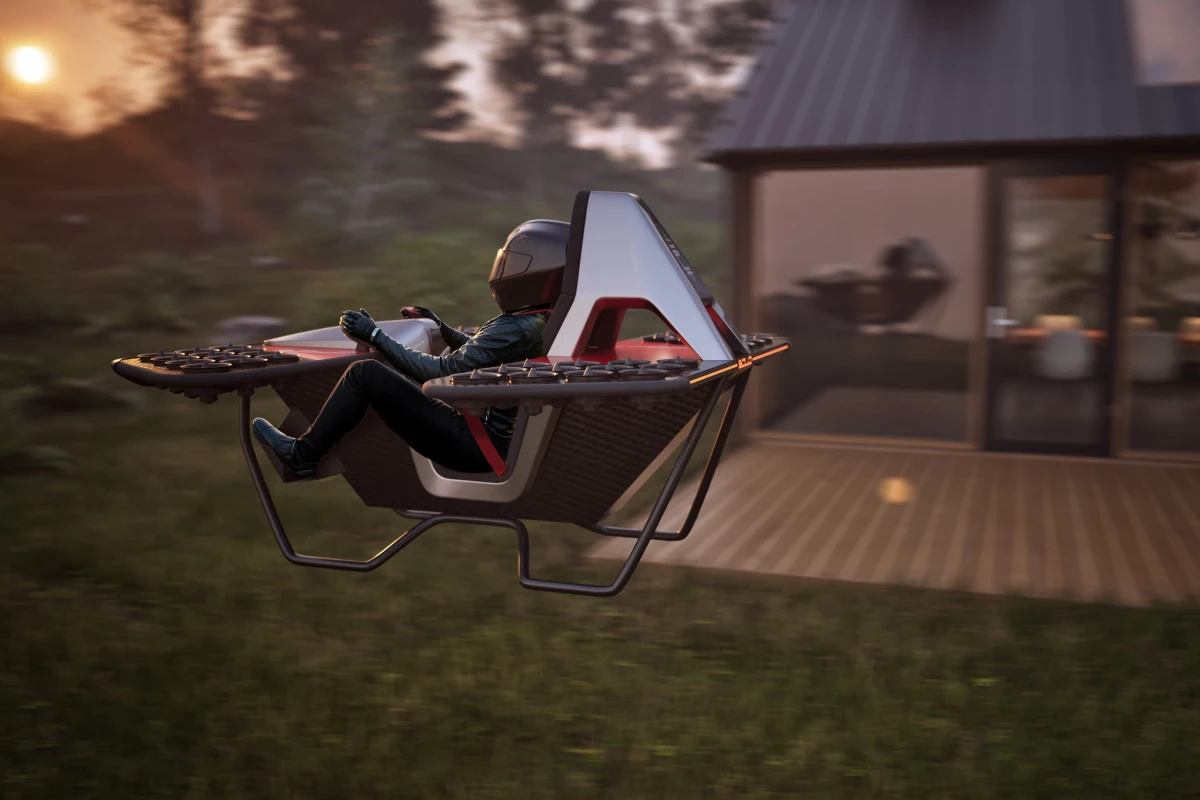The LEO Solo is now available for preorder, pitched as a Part 103-friendly (no pilot license required), single-seat personal eVTOL. It's apparently going to production in late 2025, which according to our watches is about right now.
Behind LEO Flight Corp, the company offering up these personal flight machines, is an interesting duo. Pete Bitar – who is probably on OSHA's speed dial – is the chief architect of numerous eyebrow-raising electric-jet propulsion devices over the years, an emerging patron saint of unfinished projects ... His partner Carlos Salaff is a former Mazda designer with actual real-world vehicles to show for it.
Bitar supplies the quirky electric microjet thrust obsession, while Salaff supplies the "this shouldn't look like a lawn chair strapped to a bunch of trash barrels on wheels."
In 2018, Bitar launched the company ElectricJet. From it, he's started up at least a half dozen interesting personal flight projects, built prototypes, and posted a remarkable number of "first test!" videos...
Kudos to Bitar for not being afraid to show the less glamorous side of aviation and innovation, but if there's a theme here, it's "dynamic instability," and the videos tend to abruptly end right before things look like they're going to get interesting. Bitar's personal YouTube is stocked with ~1-minute videos of tinkerer fever-dreams that we'd all love to see as finished products – even if you'd need to sign extensive waivers to use them.
The VertiCycle (which in prototype form absolutely did look like a lawn chair strapped to a bunch of trash barrels) was supposed to be a flying motorcycle of sorts. The EJ-1S (shown above) was supposed to be a personal jet pack – with matching jet boots, no less – for personal mobility. The CanopE-Jet promised to be a game-changer in switching ICE engines into electric propulsion for paragliders.

In 2021, Carlos Salaff joined the whirlwind to create Indiana-based LEO Flight and appears to have brought a degree of focus to Bitar's creative chaos. Right away, in August of 2021, Leo Flight announced its first product – virtually, might I add – the 250-mph (402-km/h) LEO Coupe flying car. A radical switch from anything ElectricJet had ever pushed out to the public. To date, the finished Coupe remains in CGI format only, though Bitar has built a prototype frame for it.
But with Salaff's expertise and creativity in car design, the Coupe looks like something we'd all want, even if it didn't fly. After all, according to Salaff's bio, he was, at least in part, responsible for the designs of the Mazda Nagare and Furai concept cars.
And now he's turned his aesthetic attention to the flying motorcycle concept. LEO Flight has opened up fully refundable US$999 deposits to reserve the latest in personal flight: the LEO Solo.
I certainly have no PhD in aerospace engineering (or anything else for that matter), but I am aware of a few basic fundamentals. Wingless VTOL aircraft need constant vertical thrust to stay in the air. Today's high-powered batteries are still very heavy for the amount of energy they carry. And these kinds of small electric jets are a highly inefficient way of delivering constant vertical thrust from a heavy battery pack.
Disc loading is a fancy term for how efficiently an aircraft generates lift. Technically, it's the weight of the aircraft divided by the square footage of the swept rotor area.
Conventional helicopters, for example, have a pretty low disc loading thanks to their huge swept rotor area. Hobby drones have a medium disc loading – they don't weigh much to begin with, and usually use four or more comparatively large-diameter rotors to spread the load.
Electric ducted mini-fans on an aircraft like the LEO Solo, on the other hand, have astronomically high disc loading. They'll have to spin furiously to move enough air to lift vehicle and pilot, and will burn significantly more energy to push the ground away than something with larger-diameter props like the Jetson.

In the CGI renders of the LEO Solo, I count 48 electric fans – 12 at each corner. Great for redundancy, great for a sleek look, great for safety without exposed props ... but less great for disc loading. LEO's site says the Solo is good for 10-15 minutes of flight, with an electronically limited top speed of 60 mph (97 km/h) at an electronically limited altitude of 15 feet (4.57 m) using a solid-state battery that you can charge at home.
A solid-state battery? Well, that changes the equation a bit, as it would for electric cars, electric motorcycles and every other electric aircraft on the market. These next-gen batteries carry a lot more energy per weight than today's heavy cells, with fast charging, much less fire risk and longer life spans. They're also not commercially available – most of the car companies that are talking about using them are looking at 2027 for the launch of demo vehicles, which is going to make it tough for LEO to hit the late-2025 production date specified in this January press release.
Anyway, LEO Flight says the Solo will fly at about 80 decibels, so it'll sound like a high-powered Dyson vacuum as it buzzes by 10 feet (~3 meters) overhead. The Solo's footprint is fairly compact at 6.5x6.5 feet (~2x2 m). That's about the size of a king-size bed, so it should fit in your garage next to your replica NASA lunar rover you use to check the mail with.
Aside from that, the team hasn't released any other technical specs or general information on the Solo – but there are now a couple of untethered, piloted test-flight videos showing brave individuals taking gingerly to the air in the boxy prototype platform. Check them out:
These short hops are encouraging, and things are looking decently stable in that second one, especially given the aerodynamic complexities you get when you're flying this close to the ground.
It's early days yet, though – and this box-framed prototype doesn't look much like Salaff's sexy renders. Between this, and the solid-state battery (and the fact that it's already late 2025), late 2025 is looking like an optimistic timeline for the production Solo. But the LEO team is making progress, and if there's one thing we're sure of, it's that Pete Bitar won't fail due to a lack of perseverance!
Source: LEO Flight Solo
New Atlas may receive commission from purchases through our Amazon links








